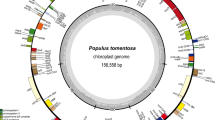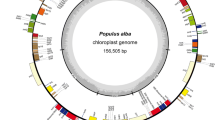Abstract
Unique historical factors and ecological conditions make Southwest China a natural distribution and variation center for trees of the genus Populus in China. However, little is currently known about the native poplars occurring in this region, and considerable doubt still exists regarding the classification and evolutionary relationships of poplar species. In this study, nuclear and chloroplast DNA (cpDNA) sequences were utilized to determine the genetic relationships and phylogeny of Populus species in Southwest China. The results suggest that P. pseudoglauca belongs to the section of Tacamahaca. Further, P. schneideri may be a natural hybrid of P. kangdingensis and P. cathayana and, thus, it should likely not be regarded as a variety of P. kangdingensis, as in the existing classification system. In addition, cluster analyses showed that P. gonggaensis may be derived from a cross between species of section Leucoides and P. cathayana or P. schneideri of section Tacamahaca, although it is still doubtful whether P. gonggaensis can be regarded as a separate species, due to its narrow distribution range. The parents of the Luding poplar may be P. yunnanensis and P. lancifolia. P. butuoensis showed a close affinity to species of section Leucoides and had a close relationship with P. gonggaensis or P. lasiocarpa. However, further research is needed in order to appropriately classify these as species or varieties. The incongruence between phylogenetic trees based on nuclear- and chloroplast-DNA sequence data may be due to the different inheritance patterns between nuclear- and cpDNA genome.



Similar content being viewed by others
References
Bassam BJ, Caetano-Anolles G, Gresshoff PM (1991) Fast and sensitive staining of DNA in polyacrylamide gels. Anal Biochem 196:80–83
Braatne JH, Hinckley TM, Stettler RF (1992) Influence of soil water supply on the physiological and morphological components of plant water balance in Populus trichocarpa, Populus deltoides and their F1 hybrids. Tree Physiol 11:325–340
Brawdshaw HD, Ceulemans R, Davis J, Stettler R (2000) Emerging model systems in plant biology: poplar (Populus) as a model forest tree. J Plant Growth Regul 19:306–313
Chao N (1991) New taxa of section Leucoides Spach of genus Populus L. J Sichuan For Sci Technol 12(3):1–3 (In Chinese with English abstract)
Chao N, Gong GT (1990) Poplars in Qinghai-Xizang Plateau of China, in: Fifth IUFRO Workshop on Protection and Management of Mountain Forests, Chengdu, China. (In Chinese with English abstract)
Chao N, Liu J (1991) Taxonomic studies on Populus L. in southwestern China (I). J Wuhan Bot Res 9:229–238 (In Chinese with English abstract)
Chao N, Liu J (2002) The family Salicaceae in Sichuan and Chongqing (I). J Sichuan For Sci Technol 23(2):1–7 (In Chinese with English abstract)
Chen K, Peng YD, Wang YH, Korpelainen H, Li CY (2007) Genetic relationships among poplar species in section Tacamahaca (Populus L.) from western Sichuan China. Plant Sci 172:196–203
Dickmann DI (2001) An overview of the genus Populus. In: Dickmann DI, Isebrnads JG, Echenwalder JE, Richardson J (eds) Poplar culture in North America. NRC Research Press, Ottawa, pp 1–42
Ding TY, Fang CF (1993) New taxa of salix L. from west china. Acta Phytotaxon Sinic 31(3):277–280 (In Chinese with English abstract)
Eckenwalder JE (1996) Systematics and evolution of Populus, in: R. F. Stettler, H.D. Bradshaw, P.E. Heilman, T. M. Hinckley (Eds.), Biology of Populus and its implications for management and conservation, NRC Research Press, National Research Council of Canada, Ottawa, Ontario, Canada, pp 7–32
Fang ZF, Zhao SD, Skvortsov AK (1999) Flora of China, Volume 4. Science Press, Beijing, pp 139–274
Feng XL, He CZ, Zhang ZY, An XM, Yang K, Zhang YH (2006) Establishment and optimization of an ISSR reaction system for Populus tomentosa Carr. Joumal of Forestry University 28(3):61–65 (In Chinese with English abstract)
Gong GT (2004) The Geographic Distribution and Origin of Populus L. J Sichuan For Sci Technol 25(2):25–30 (In Chinese with English abstract)
Hamzeh M, Dayanandan S (2004) Phylogeny of Populus (Salicaceae) based on nucleotide sequences of chloroplast trnT–trnF region and nuclear rDNA. Am J Bot 91(9):1398–1408
Hamzeh M, Périnet P, Dayanandan S (2006) Genetic relationships among species of Populus (Salicaceae) based on nuclear genomic data. J Torrey Bot Soc 133(4):519–527
Haufler CH, Grammar WA, Hennipman E, Ranker TA, Smith AR, Schneider H (2003) Systematics of the ant-fern genus Lecanopteris (Polypodiaceae): testing phylogenetic hypotheses with DNA sequence. Syst Bot 28:217–227
Hauk WD, Parks CR, Chase MW (2003) Phylogenetic studies of Ophioglossaceae: evidence from rbcL and trnL–F plastid DNA sequences and morphology. Mol Phylogenet Evol 28:131–151
Li KY, Huang MR, Wang MX, Chen DM, He ZX (1996) Study on DNA polymorphisms and phylogenetics of Populus: Aigeiros, Tacamahaca and Leuce section. J Nanjing For Univ 20(1):6–11
Li SW, Zhang ZY, He CZ, An XM (2004) Progress on hybridization breeding of poplar in China. World For Res 17(2):37–41
Liu YQ, Fu DR (2004) Development and utilization of section Tacamachaca gene resources on the Plateau of Western Sichuan. J Cent South For Univ 24(5):129–131
Lu JM, Li DZ, Gao LM, Cheng X, Wu D (2005) Paraphyly of Cyrtomium (Dryopteridaceae): evidence from rbcL and trnL–F sequence data. J Plant Res 118:129–135 (In Chinese with English abstract)
Ma CG (1994) Summarizing Chinese poplar breeding based on development and achievements of global poplar cross-breeding. World For Res 3:23–30
Maddison DR, Maddison WP (2001) MacClade 4. Sinauer, Sunderland, MA, USA
Nei M, Li WH (1979) Mathematical model for studying genetic variation in terms of restriction endonuclease. Proc Natl Acad Sci 76:5269–5273
Page RD (2000) Extracting species trees from complex gene trees:reconciled trees and vertebrate phylogeny. Mol Phylogenet Evol 14:89–160
Schneider S, Roessli D, Excofier L (2000) Arlequin ver. 2.000: a Software for Population Genetic Data Analysis. Genetics and Biometry Laboratory, University of Geneva, Geneva, Switzerland
Skog JE, Zimmer EA, Mickel JT (2002) Additional support for two subgenera of Anemia (Schizaeaceae) from data for the chloroplast intergenic spacer region trnL–F and morphology. Am Fern J 92:119–130
Small RL, Lickey EB, Shaw J, Hauk WD (2005) Amplification of noncoding chloroplast DNA phylogenetic studies in lycophytes and monilophytes with a comparative example of relative phylogenetic utility from Ophioglossaceae. Mol Phylogenet Evol 36:509–522
Smith RL (1988) Phylogenetics of Populus L. (Salicaceae) based on restriction site fragment analysis of cpDNA. M.S. thesis, University of Wisconsin, Madison, Wisconsin, USA
Sneath PHA, Sokal RR (1973) Numerical Taxonomy. Freeman, San Francisco
Song HZ, Zhang QW, Zhou CJ (2007) Analysis of genetic diversity of some species in Populus by AFLP Marker. Sci Silvae Sinicae 43(12):64–69 (In Chinese with English abstract)
Swofford DL (2001) PAUP*: Phylogenetic analysis using parsimony (* and other methods). Version 4.0b8 for Macintosh. Sinauer, Sunderland, Massachusetts, USA
Thompson JD, Higgins DG, Gibson TJ, Clustal W (1994) Improving the sensitivity of progressive multiple sequence alignment through sequence weighting, position, specific gap penalties and matrix choice. Nucleic Acids Res 22:4673–4680
Vos P, Hgers R, Bleeker M, Reijams M (1995) AFLP: a new technique for DNA fingerprinting. Nucleic Acids Res 23:4407–4414
Wan XQ, Zhang F, Zhong Y, Wang CL, Ding YH (2009) Conservation and application of the genetic resource of native poplars in Southwest China. Sci Silvae Sinicae 45(4):139–142 (In Chinese with English abstract)
Wang Z, Dong SL (1988) Geographical distribution and classification of Chinese poplars, in: Poplar. Harbin Press, China, pp 13–81 (In Chinese with English abstract)
Weisgerber H, Han Y (2001) Diversity and breeding potential of poplar species in China. For Chron 77:227–237
Yu SQ, Liu J, Fu DR, Liu DJ, Liu YQ (2003) Characteristics of Tacamachaca genes in the Western Sichuan Plateau. J Zhejiang For Coll 20(l):27–31 (In Chinese with English abstract)
Zhang HP, Niu JX, Ma BG, Hu HF, Wang GA (2003) Method of DNA extraction and RAPD reaction system in Walnut. J Shihezi Univ (Natural Sciences) 7(4):267–270 (In Chinese with English abstract)
Acknowledgments
This project was jointly supported by the 12th Five Years Key Programs for forest breeding of Sichuan province (No. 2011YZGG) and the Key Laboratory of Genetics and Breeding in Forest Trees Beijing (No.FOP2010-7). We gratefully acknowledge the contribution made by Profs. Chao N., Gong G.T., He J.R., Liu J., and Yu S.Q. in classification of native poplar in Southwest China and other relative studies in this manuscript.
Author information
Authors and Affiliations
Corresponding author
Rights and permissions
About this article
Cite this article
Wan, X.Q., Zhang, F., Zhong, Y. et al. Study of genetic relationships and phylogeny of the native Populus in Southwest China based on nucleotide sequences of chloroplast trnT–trnF and nuclear DNA. Plant Syst Evol 299, 57–65 (2013). https://doi.org/10.1007/s00606-012-0702-9
Received:
Accepted:
Published:
Issue Date:
DOI: https://doi.org/10.1007/s00606-012-0702-9




